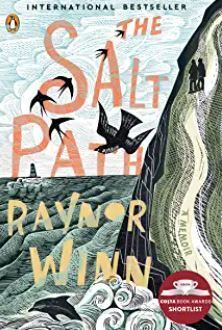
The Salt Path: A Memoir
By Raynor Winn. Penguin, 2018, 271 pp.
Imagine that you are 50 years old, you have just lost your farm, which was not only your home but also your livelihood, and you've learned that your husband, whom you've passionately loved since you were both teenagers, has a degenerative brain disease that is untreatable—what do you do?
If you're Raynor Winn, you decide that what you and your husband, Moth, should do is walk England's South West Coast Path, 630 miles, wild camping along the way. This may not seem the most logical solution—especially since the doctor's advice to Moth was "Don't tire yourself, or walk too far." And yet this plan proves to be an extraordinarily successful remedy, restoring dignity, health, and, ultimately, prosperity.
In The Salt Path, Winn takes us on a very personal journey, engrossing on two levels. On one hand, there is the daily tramp. She describes the landscapes, often dramatically beautiful, with which they engage firsthand—as Patrick Leigh Fermor says, "On foot, unlike other forms of travel, it is impossible to be out of touch." She details their day's slog, as they deal with the climate, the terrain, the pervasive hunger that their limited budget subjects them to, and the nightly challenge of finding a place to camp—a challenge not always successfully negotiated, as we see in the prologue where a rising tide nearly sweeps them away.
On another level, in the face of loss, illness, and possibly impending death, the couple find themselves confronting their future and the very meaning of their lives. Winn writes openly about her feelings and fears, and her observations about homelessness are provocative.
"The public's perception of the homeless assumes drink, drugs and mental health issues, and prompts fear," she says. She discovers that if she tells people that she and Moth lost their home, they wince and turn away. But if she says that they sold their home and have set out for "a midlife adventure," people respond with gasps of "wow, brilliant, inspirational."
They take to telling the lie—"easier for them, easier for us"—and interestingly, she finds that repeating the lie reduces their grief. Eventually they find that people are so impressed by their walking the path at their age—"old people walking," says one young woman—that their pride in the accomplishment emerges more fully.
Winn has a good sense of humor, and she applies it with excellent timing throughout the book. In one entertaining thread, people keep mistaking Moth for the poet Simon Armitage—who apparently is also walking the path and planning on doing readings—teasing him about traveling incognito.
Another thread involves Paddy Dillon, whose guide, The South West Coast Path: From Minehead to South Haven Point, they are following—but at a far slower speed. "Paddy Dillon is probably superhuman," writes Winn. "In fact I'm convinced he's ex-Special Air Service, eats raw seaweed for breakfast, runs marathons when there's nothing on TV and wears camouflage pajamas."
Moth's health improves on this arduous trek: although he couldn't move without pain before setting out, he now gains strength and agility. Why remains something of a mystery, though the fact that he fares less well on their winter break suggests that the walking itself is healing.
By the end of the journey, the couple are able to make plans for a new life. Readers interested in finding out about their next steps can turn to The Wild Silence:A Memoir, Raynor's follow-up to this popular book.